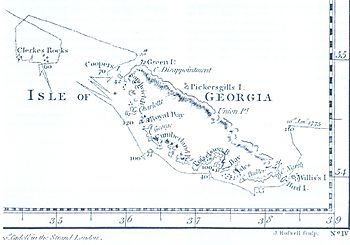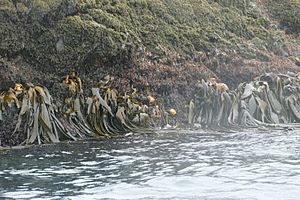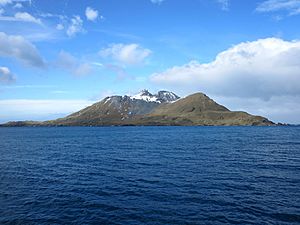Cooper Island facts for kids

Southeast extremity of South Georgia
with Cooper Island |
|

Cooper Island can be seen on Cook's 1777 South-Up map
|
|
| Geography | |
|---|---|
| Coordinates | 54°48′S 35°47′W / 54.800°S 35.783°W |
| Archipelago | South Georgia |
| Length | 2 mi (3 km) |
| Highest elevation | 1,365 ft (416.1 m) |
| Administration | |
|
United Kingdom
|
|
| Demographics | |
| Population | 0 |
Cooper Island is a small island located near South Georgia. It is about 2 miles (3.2 kilometers) long. You can find it at the northern entrance of Drygalski Fjord.
A famous British explorer, James Cook, discovered Cooper Island in 1775. He named it after Lieutenant Robert Palliser Cooper. He was an officer on Cook's ship, HMS Resolution.
There is a narrow waterway called Cooper Sound that separates Cooper Island from the main island of South Georgia. It is almost 1 mile (1.6 kilometers) wide. There is also a small area of water called Cooper Bay nearby. It is about 1.3 miles (2.1 kilometers) southwest of Cape Vahsel. This bay also got its name from Cooper Island.
The highest point on Cooper Island is about 1,365 feet (416 meters) tall. The very top parts of the island are often covered in snow.
Amazing Wildlife on Cooper Island
Cooper Island is a very special place for animals. It is one of the few islands in the area that does not have rats. This means it is a safe home for many kinds of birds and other creatures.
Because it is rat-free, Cooper Island is South Georgia's only Special Protection Area. This helps keep its unique wildlife safe.
You can find many sea birds here, including:
- Snow petrels
- Antarctic prions
- About 12,000 pairs of black-browed albatross
- Chinstrap penguins
- Around 20,000 macaroni penguins
The island is also home to many fur seals. This is one of the few places where people did not hunt them in the past. The island is mostly covered in a type of plant called tussock grass.

See also
 In Spanish: Isla Cooper para niños
In Spanish: Isla Cooper para niños


